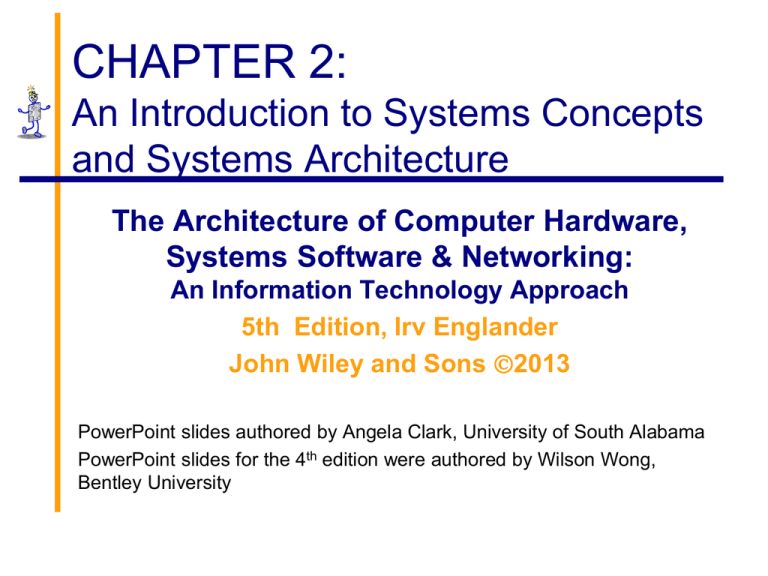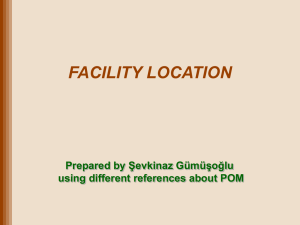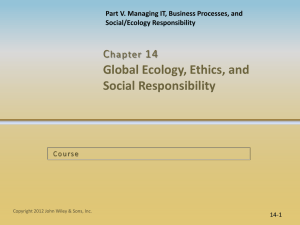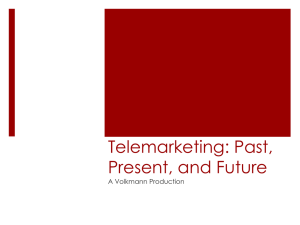
CHAPTER 2:
An Introduction to Systems Concepts
and Systems Architecture
The Architecture of Computer Hardware,
Systems Software & Networking:
An Information Technology Approach
5th Edition, Irv Englander
John Wiley and Sons 2013
PowerPoint slides authored by Angela Clark, University of South Alabama
PowerPoint slides for the 4th edition were authored by Wilson Wong,
Bentley University
What is a system?
What do the following systems have in
common?
1.
2.
3.
4.
Plumbing system
Solar system
Home network system
Inventory control system
Copyright 2013 John Wiley & Sons, Inc.
2-2
Plumbing System
Copyright 2013 John Wiley & Sons, Inc.
2-3
Solar System
Copyright 2013 John Wiley & Sons, Inc.
2-4
Home Network System
Copyright 2013 John Wiley & Sons, Inc.
2-5
Inventory Control System
Copyright 2013 John Wiley & Sons, Inc.
2-6
Definition of a System
“A system is a collection of components
linked together and organized in such a
way as to be recognizable as a single
unit.”
Linked components of a system also
define a boundary for the system
The environment is anything outside of
the system
Copyright 2013 John Wiley & Sons, Inc.
2-7
General Representation of a
System
Copyright 2013 John Wiley & Sons, Inc.
2-8
System Decomposition
Components
May be irreducible or
May be subsystems
Decomposition
The division of a system into its
components and linkages
Hierarchical
Copyright 2013 John Wiley & Sons, Inc.
2-9
System Architecture
“The fundamental properties, and the
patterns of relationships, connections,
constraints, and linkages among the
components and between the system
and its environment are known
collectively as the architecture of the
system”
Copyright 2013 John Wiley & Sons, Inc.
2-10
Abstractions of Systems
How are the following two abstractions
of a business system different from one
another?
How are these abstractions different
from the real business system?
Copyright 2013 John Wiley & Sons, Inc.
2-11
Business Organization Chart
Copyright 2013 John Wiley & Sons, Inc.
2-12
Business Application
Architecture
Copyright 2013 John Wiley & Sons, Inc.
2-13
IT System Architectures
Distributed processing systems
Client-Server Computing
Two-tier architecture
Three-tier architecture
N-tier architecture
Web-Based Computing
Cloud Computing
Peer-to-Peer Computing
Copyright 2013 John Wiley & Sons, Inc.
2-14
Client-Server Computing
A program on a client computer
requests services from a program on a
server computer
Examples:
Email services, file services, print services,
directory services, Web services, database
services, application services, remote
access services
Copyright 2013 John Wiley & Sons, Inc.
2-15
Basic Client-Server Architecture
Copyright 2013 John Wiley & Sons, Inc.
2-16
Advantages of Client-Server
Architecture
Centralization of services permits
easier administration of services by IT
professionals
easier availability and location by users
consistency of resources, such as files and
data, can be managed and assured
more efficient and cost-effective hardware
procurement through purchasing a small
number of very powerful computers
Copyright 2013 John Wiley & Sons, Inc.
2-17
Clients and Servers on a Network
Copyright 2013 John Wiley & Sons, Inc.
2-18
Multi-tier Architectures
Two-tier architecture
Two computers are involved in a service
Example: Web browser and Web server
model used in intranets and on the Internet
Three-tier architecture
Three computers are involved in a service
Example: client computer, Web server,
database server
N-tier architecture
Copyright 2013 John Wiley & Sons, Inc.
2-19
Three-tier Web-based Email
Architecture
Copyright 2013 John Wiley & Sons, Inc.
2-20
Cloud Computing
Off-site storage facilities for an organization
Software as a service (SaaS): applications
run on a server or processing may be divided
on server and client
Platform as a service (PaaS): tools for a
developer to create and run applications on a
cloud platform
Infrastructure as a service (IaaS) – cloudbased hardware emulation of virtual
machines and networking
Copyright 2013 John Wiley & Sons, Inc.
2-21
Cloud Computing Advantages/Risks
Advantages
Client’s datacenter needs are simplified; reduced costs
Supports collaboration
Scalable to a variety of host platforms
Reduced maintenance downtime
Lower investment for short-term projects
Risks
Quality of security is critical
Outages or loss of connectivity may prevent users from
working
Requires long-term commitment and viability of cloud service
Changes in operating procedures can result in data loss
Copyright 2013 John Wiley & Sons, Inc.
2-22
Peer-to-Peer Computing
Computers on a network are treated as equals
Each computer can share resources with the other
computers on the network
Disadvantages
Difficult to establish centralized control of services
Difficult to locate services
Difficult to synchronize versions of files or software
Difficult to secure network from unauthorized access and
from viruses
Advantages
Sharing files between personal computers
Internet file sharing
Copyright 2013 John Wiley & Sons, Inc.
2-23
Hybrid Model of Computing
Client-server technology used to locate
systems and files
Then systems can participate in peer-topeer transactions
Examples
Instant messaging
Skype
Napster
Copyright 2013 John Wiley & Sons, Inc.
2-24
Google: System Architecture
Provide powerful, fast search capability for material
on the Internet
Derive income from advertising that is targeted to
each user based on their searches
Basic requirements
Capable of responding to millions of simultaneous requests
from all over the world
Perform a web crawl of the Internet to retrieve and organize
data
Establish ranking of results with appropriately targeted
advertising
High reliability of the system
System is easily scalable and cost effective
Copyright 2013 John Wiley & Sons, Inc.
2-25
Google Data Center Search
Application Architecture
Copyright 2013 John Wiley & Sons, Inc.
2-26
Simplified Google System
Hardware Architecture
Copyright 2013 John Wiley & Sons, Inc.
2-27
Facebook’s Application Architecture
N-tier architecture
Based entirely on open source software
Serves as an intermediary between web
browser and an application provider’s
Web service
API and protocols allow information
exchange between Facebook servers
and the application server
Copyright 2013 John Wiley & Sons, Inc.
2-28
Copyright 2013 John Wiley & Sons
All rights reserved. Reproduction or translation of this
work beyond that permitted in section 117 of the 1976
United States Copyright Act without express permission
of the copyright owner is unlawful. Request for further
information should be addressed to the Permissions
Department, John Wiley & Sons, Inc. The purchaser
may make back-up copies for his/her own use only and
not for distribution or resale. The Publisher assumes no
responsibility for errors, omissions, or damages caused
by the use of these programs or from the use of the
information contained herein.”
Copyright 2013 John Wiley & Sons, Inc.
2-29









